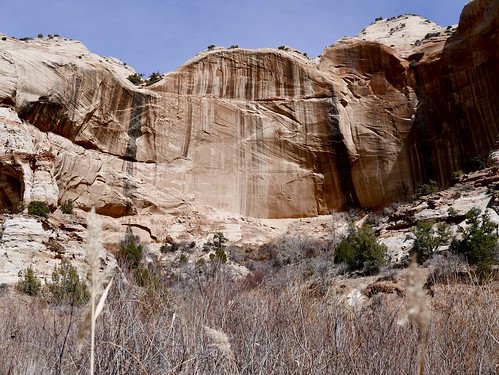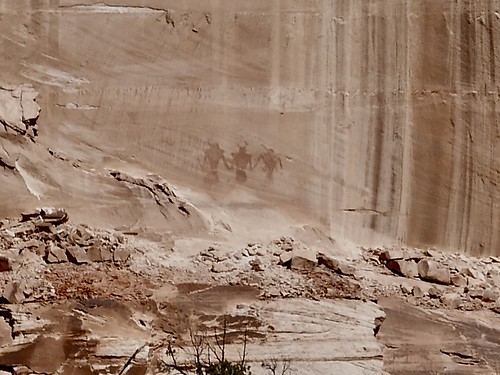
A closer look:

Photographed today at Calf's Creek Falls — on Utah highway 24.
Here's an article about the Fremont People who made these images.
The Fremont culture or Fremont people is a pre-Columbian archaeological culture which received its name from the Fremont River in the U.S. state of Utah where the first Fremont sites were discovered.... It inhabited sites in what is now Utah and parts of Nevada, Idaho and Colorado from AD 1 to 1300 (2,000-700 years ago)....
Scholars did not agree that the Fremont culture represents a single, cohesive group with a common language, ancestry, or lifeway, but several aspects of their material culture suggests they might be a single ethnic group. First, Fremont culture people foraged wild food sources and grew corn.... [They made] gray ware pottery and a signature style of basketry and rock art. Most of the Fremont lived in small single and extended family units comprising villages ranging from two to a dozen pithouse structures, with only a few having been occupied at any one time....




27 comments:
But did they give their women free birth control?
The Three Stooges, one of the Universal Myths that transcend every age and race.
Are they as high up on the cliff as the pictures suggest? Does the guidebook speculate on how they were carved?
Ah ha. They were from across that apocryphal land bridge to Siberia, which makes them Russians that marked their territory. And now Putin wants his land back. Which also explains why Mormon Romney feared the Russians as our most dangerous enemy.
Their only memorial is a ghostly presence on a distant cliff in a remote desert. A vague people leaving a vague memory.......They're like the opposite of Ozymandias.
Althouse finds proof of extraterrestrial 👽 life.
Quits cushy job to become an amateur UFO hunter.
More at eleven.
Very cool. By the way AA, was having serious withdrawal symptoms when you didn't post all day. Don't know what I'll do when you retire from blogging. Probably have to actually get some work done.
Alternative theory: 19th century European punking, or in the lexicon of us higher academic circles of the science, a "bamboozlement".
"In the past decade, [Camille Paglia] undertaken solitary research into the Native American tribes of southeastern Pennsylvania, collecting artifacts and noting rock formations that she believes appear manmade. She hopes this research might develop into a book, but said that her agent foresaw little commercial appeal."
Here's Paglia's earlier, typically trenchant take, this time on the anthropological academe.
I eventually concluded that academic training in North American anthropology has been so focused on highly specialized excavation protocols (where stratifications revealing Native American “lifeways” over thousands of years are painstakingly uncovered and carbon-dated) that there is no room for world art or world history in the basic curriculum, leading to a lack of speculative skill and larger vision. I see no other explanation for how much has been missed, in terms of both large and small artifacts, by specialists in Native American studies of the Northeastern states. On the Web, on the other hand, there are numerous sites by enthusiastic amateurs, who post photos of their discoveries in woods and farmland and eagerly trade theories.
Probably too late - but if you are still thinking about homemade pie, (autocorrect won't let me spell it the other way!), check out the Sunglow Cafe in Bicknell. They are known for their pinto bean pie and their pickle pie. Seriously. Both are better than you would expect.
People look into anthropology and find a mirror.
The "Fremont people" obviously did not think of themselves as "Fremont people", and they may have considered themselves not to be related to the people modern anthropologists tell us that they were related to. Who the heck is the expert? Whose word is law?
Should be titled See the Petroglyphs?
A pictograph is a form of writing, specifically a pictorial symbol for a word or phrase. Pictographs occur in ancient writing, and a some of the logograms in classical Chinese are considered pictographs, however, pictographs are most common today on charts and spreadsheets as in this example.
The petroglyphs in Bryce Canyon are not believed to be writing, per se. They may be ritualistic statements of control, as in This is my turf. Keep out! Or, they could be mere doodles significant only to the person who carved them.
The "Fremont people" obviously did not think of themselves as "Fremont people", and they may have considered themselves not to be related to the people modern anthropologists tell us that they were related to.
Naming cultures is a convention among scholars, a mode of convenience superior to "those people who lived in Britain before the Celts arrived and made that distinctive pottery". Instead of using that difficult phrase we call them the Beaker People. It isn't a matter of law, but there are experts. They are called archeologists, and their science is the only means we have to illuminate what would otherwise be a forgotten past. Some ancient cultures were smart and left us records, which if we decipher them properly, can give us their name for themselves. Others were dumb and left nothing but their refuse and doodles for us to find, in which case we name them or they are utterly forgotten — that is the choice.
There were high cultures that worked hard at leaving monuments built with durable materials and were literate, and there were low cultures that didn't work so hard. The low cultures are nevertheless important because they give context to prehistory if nothing else. Complaining about giving a name to people who are otherwise nameless seems pointless carping in my humble opinion. Perhaps someday a hard-working archaeologist will unearth a written record that will make the term Fremont People superfluous, making known to us moderns that they were the Oompah Loompahs, Chocolatiers to the Gods — but I doubt it.
Quaestor said...
Should be titled See the Petroglyphs?
Probably.
They are called archeologists, and their science is the only means we have to illuminate what would otherwise be a forgotten past.
Like most N. American Amerindians, the Fremont/etc are pretty boring. About the only visible change in their artifacts over hundreds of years is the type of stripes they put on the pottery. I think it's kinda nutty how people - NPS white folks and a very few local Indians who aren't descendants - think this repetitive old trash is significant somehow, maybe even magical.
"Scholars did not agree that the Fremont culture represents a single, cohesive group with a common language, ancestry, or lifeway, but several aspects of their material culture suggests they might be a single ethnic group."
They fought with someone, probably each other, a lot, which is why the dwellings are built on cliffs. People have found entire villages whose skeletons have had their ankles broken by their neighbors, perhaps the result of a dispute over dogs barking at night.
Route 24 - on my list.
Quaestor said...
The petroglyphs in Bryce Canyon are not believed to be writing, per se.
I lived in Mexican Hat for three years and there are petroglyphs and ruins (cliff dwellings and towers), all over the place, esp. the plateau between Natural Bridges and Mexican Hat (rt 261), which has water and pine trees...and a great view of the San Juan river canyon and Monument Valley. The petroglyphs are too simple and repetitive to carry much information other than, as you said, something like "this is our spot" or "found sheep here".
As my mother says, "What's the difference between petroglyphs and graffiti?"
If you read this, I recommend a visit to the Potash petroglyphs just outside Moab while you're in the area. EXTREMELY acessible, lterally next to your car when you pull off the shoulder, and there are dozens.
"People look into anthropology and find a mirror."
Physical anthropology can be pretty thin stuff, long on speculaton and short on facts. For who can say what the cultural significance of the art and artifacts recovered?
I wish I could remember the author of that short story about physical anthropologists in the far future uncovering a Catholic church. They assume the church was celebrating fertility (because of the Mother and Child statues), and that that the crucified man is shown as an example of what happens to a man who harms a mother or her child.
Even practical implements were often included art that was not necessary for their utilitarian purpose, and who can say what that art meant to the people who used these implements? And, even what appears to be fine art lacking utility may have seemed utilitarian to those who created and used it (e.g., the use of animal depictions might be a request to God or gods for success in hunting).
I'm sure this stuff is fascinating, but, once one gets away from boring, quotidian details (such as strata, material, C14 dating) one inevitably leaves the world of science and wanders into the hallways of speculation.
accessible, literally
I'm sure this stuff is fascinating, but, once one gets away from boring, quotidian details (such as strata, material, C14 dating) one inevitably leaves the world of science and wanders into the hallways of speculation.
I'm sure you don't know what you're talking about.
'They are known for their pinto bean pie and their pickle pie. Seriously. Both are better than you would expect."
Not a high accolade. Stay on course Althouse.
Pickle farts in a closed car. Not good.
I wish I could remember the author of that short story about physical anthropologists in the far future uncovering a Catholic church. They assume the church was celebrating fertility (because of the Mother and Child statues), and that that the crucified man is shown as an example of what happens to a man who harms a mother or her child.
The Stations of the Cross plaques didn't survive the dig, apparently... Nor the relative position of the crucified man (front and center, behind or over the altar) versus the statuary (off to the side). Nor the halo the crucified man was usually depicted with. Nor...
Sounds like the archaeologists of the future kinda suck.
On the other hand, I did like the story about unearthing an office full of tiny cubicles and assuming it was part of the prison system.
Ann, that's great you were able to get to Calf Creek (I was the unknown who suggested it when you were asking for recommendations). It looks like spring hasn't quite kicked in yet. Did you make it all the way up to the falls?
Thank you for posting this. We visited when I was about your age, a favorite place. I know at age 80 I will never get to see it in person again. So thank you.
Post a Comment
Please use the comments forum to respond to the post. Don't fight with each other. Be substantive... or interesting... or funny. Comments should go up immediately... unless you're commenting on a post older than 2 days. Then you have to wait for us to moderate you through. It's also possible to get shunted into spam by the machine. We try to keep an eye on that and release the miscaught good stuff. We do delete some comments, but not for viewpoint... for bad faith.